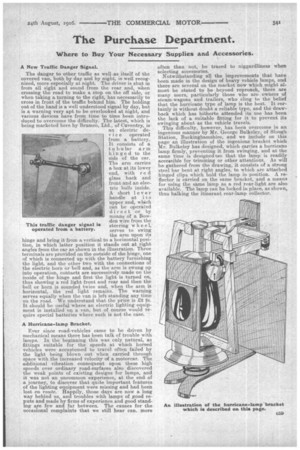The Purchase Department.
Page 19

If you've noticed an error in this article please click here to report it so we can fix it.
Where to Buy Your Necessary Supplies and Accessories.
A New Traffic Danger Signal.
The danger to other traffic as well as itself of the covered van, both by day and by night, is well recognized, more especially at night. The driver is shut in from .all sight and sound from the rear and, when crossing the road to make a stop on the off side, or when taking a turning to the right, has necessarily to cross in front of the traffic behind him. The holding out of the hand is a well understood signal by day, but is a warning very apt to be overlooked at night, and various devices have from time to time been introduced to overcome the difficulty. The latest, which is being ma,rketed here by Brame°, Ltd., of Coventry, is an electric device operated from a battery. It consists of a tubular arm hinged to the side of the car. The arm carries a box at its lower end, with red glass back and front and an electric bulb inside. A short lever handle at its upper end, which can be operated direct or by means of a Bowden wire from the steering wheel, serves to swing the arm upon its hinge and bring it from a vertical to a horizontal position, in which latter position it stands out at right angles from the car as shown in the illustration. Three terminals are provided on the outside of the hinge, one of which is connected up with the battery furnishing the light, and the other two with the connections of the electric horn or bell and, as the arm is swung up into operation, contacts are successively made on the inside of the hinge and first the light is turned on, thus showing a red light front and rear and then the bell or horn is sounded twice and, when the arm is horizontal, the red light remains. The warning serves equally when the van is left standing any time on the road. We understand that the price is 22 2s. It should be useful where an electric lighting equipment is installed on a van, but of course would require special batteries where such is not the ease. This traffic danger signal is operated from a battery.
A Hurricane-lamp Bracket.
Eversinee road-vehicles came to be driven by mechanical means there has been talk of trouble with lamps. In the beginning this was only, natural, as fittings suitable for the speeds at which horsed vehicles were accustomed to travel often• failed by the light being blown out when carried through Space with the increased velocity of a motorcar. The additional vibration consequent upon these high speeds over ordinary road-surfaces also discovered the weak points of existing designs for lamps, and it was not an uncommon experience, at the end of a journey, to discover that quite important features of the lighting equipment were missing and had been lost en route. Happily, those days are now a long way behind us. and troubles with lamps of good repute and made byfirms of experience and good standing are few and far between. The causes for the occasional complaints that we still hear can. more often than not, be traced to niggardliness when selecting accessories. Notwithstanding all the improvements that have been made in the design of heavy vehicle lamps, and there are several on the market now which might almost be stated to be beyond reproach, there are many users, particularly those who are owners of steam-wagons and. trailers, who cling to the belief that the hurricane type of lamp is the best. It certainly is without doubt a reliable type, and the drawback which has hitherto attended its use has been the lack of a suitable fitting for it to prevent its swinging about as the vehicle travels.
.This difficulty, however, has been overcome in an ingenious manner by Mr. George Bulkeley, of Slough Station, Buckinghamshire, and we include on this page an illustration of the ingenious bracket which 111r. Bulkeley has designed, which carries a hurricane lamp firmly, preventing it from swinging, and at the i same time s designed eso that the lamp is readily accessible for trimming or other attentions. As will be gathered from the drawing, it consists of a strong steel bar bent at right angles, to which are attached hinged clips which hold the lamp in position. A reflector is carried on the same bracket, and a means for using the same lamp as a red rear-light are also available. The lamp can be locked in place, as shown, thus balking the itinerant rear-lamp collector.




















